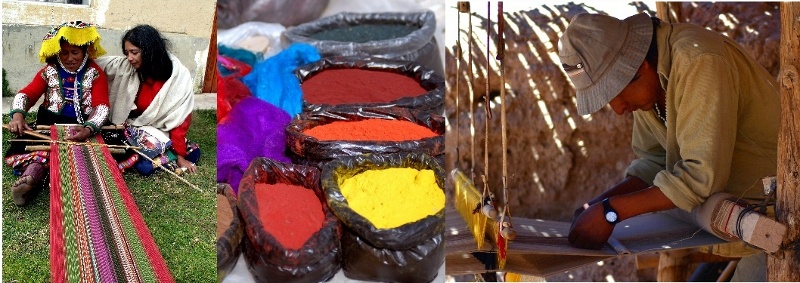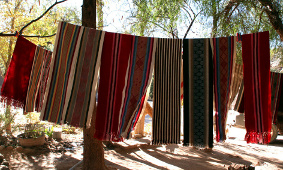 This article has originally been published in the online version of the HandEye magazine, and is republished with permission.
This article has originally been published in the online version of the HandEye magazine, and is republished with permission.
There is this ‘special something’ in her eyes, and her gestures animatedly accompany every single of her stories. Stories of highly skilled Andean artisans living in bitter poverty in small rural communities somewhere between the Northern tip of the Andes in Venezuela, and its Southern counterpart in Patagonia, close to Fireland. Adriana Marina, the driving force behind the Andean social enterprise Animanà (meaning ‘a place in heaven’ in the almost extinct Kakane language), is indeed a femme extraordinaire. It is thanks to her that three complementary organisations have been brought to life:
The ‘Ethical Fashion Forum Latin America‘ which promotes a holistic response to the fashion process in order to meet present needs without compromising future generations. The forum assembles under its wings professionals, academics, commercial organisations and experts from the fashion industry interested in promoting social, economic and environmental responsibility through fashion. Then, ‘Hecho x [por] Nosotros‘, a grassroots not-for-profit that works with artisans across the entire length of the Andes to recover their ancestral techniques and adapting them to the needs and quality criteria of modern customers.
And finally the social enterprise Animanà.
Animanà is a calling to give the world an alternative production model that connects the market with the artisans who live in marginal areas of the Andean region. The enterprise is a cultural bridge with information going one way, in exchange for cultural richness and historical knowledge that for a long time was believed lost. Through advocating the recovery of culture, arts and ancient secret of the Andes, and the collaboration with local artisans to market their products for what they are worth, Animanà creates livelihoods, acts as catalyst for development in the Andes, and has become a distributor of innovative knowledge and techniques on an international level. At heart though, what the enterprise aims to resolve are fairly simplistic questions: How come that so many an artisan creates the most beautiful of products, using highly accomplished techniques and skills – and yet they do not seem to be able and make a living from it? How can it be prevented that they loose the knowledge about and motivation to practise their ancestral textile heritage in a modern, consumer-oriented, short-lived and globalised world?

Animanà’s short answers to both these questions are ‘collaboration’, ‘design’ and ‘trade’. The organisation aims at tackling the balancing act between the high-end consumers’ demands – specifically in interior design and fashion – and the rural artisans’ production capacity and survival needs. This is done by supporting the artisans in turning out products of consistently high quality and modern design, by paying them in accordance to what the real value of the products is, and by finding the markets and market niches that appreciate the attributes of exclusivity for what they are worth. Animanà’s point of departure in short is where others previously considered their mission accomplished. The work is holistic, yet at the same time systematic, even scientific in its endeavours to make space for their artisans’ products in the heavily competitive international luxury interiors and fashion market. Discipline is as much part of Animanà’s DNA as the hands-on collaboration with the artisans themselves. This thoroughness has earned them the support from both international experts – among them Dominique Peclers, a now retired international fashion trend consultant – and organisations like the UNESCO who through their “Equity for Applied Arts” program supports the design and marketing efforts.

The artisans Animanà’ collaborates with produce a unique amalgam of three different textile histories: their own as an artisan, their craft as ancestral heritage of their community which has been practised for as long as 5000 years, and finally, that of the traditional techniques and designs as rediscovered and reinvented in the 21st century. But producing the desired quality outcome often implies stepping back in time: Discarding technologies and achievements from the last 100 years, and reviving pre-industrial methods, by choosing natural fibres, dyes and ancestral techniques. This means, among others, advocating the use of a vast variety of natural, renewable raw materials such as alpaca, vicuña, llama, or the more Kashmir-like guanaco fleeces, Andean silk, native Peruvian cotton, or locally bred merino wool; the decision to select and hand-spin the fibres to achieve higher quality yarns while avoiding machine damage; and the use of centuries old, environmentally sound dye methods based on colour pigments obtained from the native flora and fauna, re-creating in the process the vibrant colours of historic Inca garments.
It’s more: many historical garments were never dyed to start, but rather made abundant used of the broad variety of naturally occurring plant and animal fibre colour shades. It is for instance rarely known that the natural colour gamut of alpaca wool, to take just one example, can be separated into 22 unique categories ranging from deep auburns, to soft greys, saturated blacks and browns, whites, and earth-toned shades of peach. And native Peruvian cotton – which can be traced back in Peruvian history for some 5000 years through fabrics and other sources, and which was mentioned extensively in written documents during the times of European medieval explorers due to its abundance, softness and colour variety – offers a colour gamut that includes cream, beige, brown, rust, chocolate, mauve, avocado, a dark brick red as well as other earthy tones.
The specific value of Animanà lies in the combination of an investigative approach and a social enterprise, and the fact that they managed to create markets for what was believed lost in the mist of history. In particular, their work with young Argentinian and international designers has the goal to re-introduce them to their own ancestral heritage while giving support to explore new dimensions of creativity, and is bound to have a long-term impact. It is this type of work that has added a dimension to the world of textiles, design and fashion that in this way previously never existed: One in which the designers behind the brands work on par with rural artisans, and look for inspiration beyond social classes and historic legacies.


